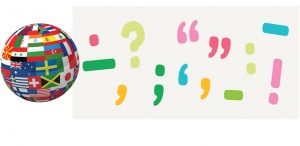Difference between revisions of "Language/Multiple-languages/Grammar/Punctuation-of-many-languages"
m |
|||
| Line 1: | Line 1: | ||
[[File:punctuation-in-many-languages.jpg|thumb|none]] | |||
== Marks == | == Marks == | ||
Revision as of 19:59, 8 June 2017
Marks
Common
| English | Japanese | Chinese | |
|---|---|---|---|
| comma | , | 、 | , |
| period | . | 。 | |
| parentheses | ( ) | () | |
| question mark | ? | ? | |
| exclamation mark | ! | ! | |
| colon | : | : | |
| semicolon | ; | ; | |
Quotation marks
| Primary | Secondary | Spacing | |
|---|---|---|---|
| English, United Kindom
Scottish Gaelic Welsh |
‘…’ | “…” | English: 1–2 pt
Welsh: 1–2 pt |
| Afrikaans
Chinese, China English, United States English, Canada Esperanto Filipino Hindi Indonesian Irish Interlingua Maltese Portuguese, Brazil Thai |
“…” | ‘…’ | English: 1–2 pt
Chinese: fullwidth Irish: 1–2 pt |
| Lao
Vietnamese |
“…” | ||
| Amharic
Azerbaijani Basque French, Switzerland German, Switzerland Italian, Switzerland Romansh Tigrinya Turkish |
«…» | ‹…› | Azerbaijani: 0–1 pt
Turkish: 0–1 pt |
| French | « … » | “…”
« … » |
¼ em |
| Belarusian
Catalan Greek Italian Occitan Portuguese, Portugal Spanish |
«…» | “…” | Catalan: none |
| Russian
Ukrainian Uzbek |
«…» | „…“ | Russian: none
Ukranian: none |
| Norwegian | «…» | ’…’ | |
| Arabic
Armenian Kazakh Khmer Latvian Mongolian Cyrillic Pashto Persian Uyghur |
«…» | Arabic: optional | |
| Danish | »…«
„…“ |
›…‹
‚…‘ |
|
| Finnish
Swedish |
”…” | ’…’ | |
| Bosnian | ”…”
„…” |
’…’ | |
| Dutch
Hebrew |
„…” | ‚…’ | |
| Serbian | „…” | ’…’ | |
| Croatian | „…” | ‘…’ | |
| Polish | „…” | «…»
»…« |
|
| Romanian | „…” | «…» | none |
| Hungarian | „…” | »…« | |
| Bulgarian | „…“ | ’…’
‘…’ |
|
| Czech
German Icelandic Slovak Slovene Sorbian |
„…“ | ‚…‘ | |
| Albanian | „…“ | ‘…’ | |
| Macedonian | „…“ | ’…‘ | |
| Estonian
Georgian Lithuanian |
„…“ | Georgian: none | |
| Chinese, Hong Kong
Chinese, Taiwan Japanese |
「…」 ﹁ |
『…』 ﹃ ﹄ |
Chinese: fullwidth |
| Korean, South Korea | 『…』
﹃ |
「…」
﹁ |
|
| Korean, North Korea
New Tai Lue Tai Le Tibetan |
《…》 | 〈…〉 | |
| Lojban | lu … li'u |
Special
『 』 「 」 title marks in Japanese
《 》 〈 〉 title marks in Chinese
♪ musical note in Japanese
¿ inverted question mark in Spanish
¡ inverted exclamation mark in Spanish
、 enumeration comma in Chinese
Usages
Special
Title marks are to indicate titles of books, movies, etc.
Musical notes are to indicate lyrics in a sentence.
Inverted question mark and inverted exclamation mark are to indicate the begining of the interrogative or exclamatory sentence or phrase.
